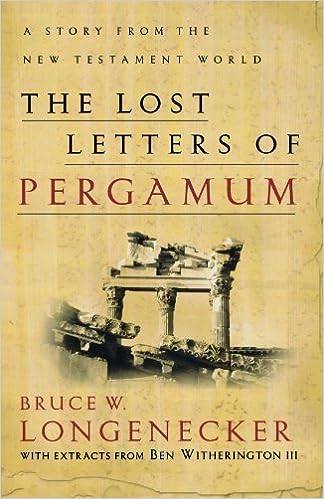Bruce W. Longnecker. Baker Academic, 2003. 190 pages.
This book is a work historical fiction. It purports to be a collection of ancient letters recently discovered, translated and published for the reading public. Through this fictional collection of letters, a story emerges which provides an imaginative reconstruction of church and daily life for people of the NT era as well as the impact that can be made by the story of Jesus.
The key interlocutor is one Antipas, a Roman nobleman of the eastern Roman empire who has entered retirement with the intention of spending it reading fine literature. He has arrived at Pergamum (a now-ruined city in western Turkey), the site of a famous library of the ancient world. The story is set in the A.D. 90s.
Through correspondence with a friend while searching for a copy of Homer’s epic poems, a copy of the Gospel of Luke is put into Antipas’ hands. Having never heard of Jesus, he is happy to read it to find out more. His curiosity is piqued, and return correspondence shows the questions and responses provoked by his reading of the initial chapters of the Gospel of Luke. Before long, he is put in touch with Luke himself and he is also directed to the home of a local aristocrat whose home hosts a local church, and his story continues from there.
The bulk of the book subdivides the letters into groups of correspondence: a letter from Antipas responding to what he has recently read in the Lukan Gospel or experienced in the church gathering, a letter response from Luke or the earlier friend, and occasional excurses by Luke or Antipas exploring facets of life in first century Palestine or puzzling features of Luke’s Gospel.
Three appendices aid the reader by providing maps, a list of characters, and an outline of what is historical and what is fictional in each section of the story. The style of the letters can be rather stiff and formal, but this is in keeping with the formal letter-writing style that is part of the genre. The book is also shorter than it appears – around half of the pages are blank or half empty.
Why is this book a worthwhile read?
- It informs the reader of the society and cultures that the NT emerged within (i.e., the Greco-Roman world and first-century Israel). It does this through the course of the correspondence as well as through the aforementioned excurses. Things include things like Jewish expectations for a Messiah in the first century, the happenings in Rome under the reign of emperor Nero, the customs of relating between upper and lower-class people, the way religion (pagan and Christian) was woven into everyday life, and insecurities of life for slaves and peasants in those times. These won’t provide new information for some readers, and the excurses do interrupt the story somewhat, but to those for whom the NT world is an unknown one it will be a useful diversion of discovery.
- It shows the practice and dynamics and influence of a Greco-Roman house church. The imaginative reconstruction of a Christian community paints a suggestive picture of how church gatherings looked (several other churches are visited in the course of the story). The main group featuring in The Lost Letters of Pergamum involves a gathering of some thirty or more diverse people in a private home to engage in a common meal, followed by the reading and discussion of Scripture, and prayer and singing. The relationships observed between different members are particularly eye-opening.
- It shows the impact of a serious reading of a Gospel. It is perhaps a problem at times that modern Christians are overfamiliar with Christian ideas so that we are never challenged by them (biblical illiteracy notwithstanding). The Lost Letters refreshes our reading of one Gospel by showing how Jesus’ teaching and example provokes and challenges readers. We see this both in a believing community and in Antipas as a curious outsider. Their genuine wrestling with the implications was for me the most rewarding aspect of the book. On the part of the main character, it is fascinating to watch his growth in understanding—both from his own discussion with Luke and from his observation of the church community, as he rethinks the way he ought to conduct himself and eventually commits himself personally to Jesus. On the part of other members of the churches, we see the care given to an ill, elderly, and impoverished peasant by other Christians, and the struggle of one tradesman to resist the growing pressure to religious (pagan) conformity in his workplace.
Although the “lost letters” are fictional, the story they tell certainly could have happened. For the reasons outlined above this is a highly helpful and stimulating book, and one which I have read several times since it was first recommended to me. As life is for Christians today, life that is committed to the ways and person of Jesus is challenging, even if they times depicted in The Lost Letters are much more brutal than what we will ever face. The story thus warns us not to expect following Jesus to be an easy path, but also highlights the value of church community and of Scriptural reflection, and inspires loyalty to Jesus despite its costs.
The Lost Letters of Pergamum is available from Fishpond for NZ$35 (price as at July 2023).

